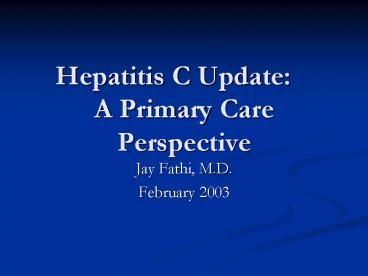Hepatitis C Update: A Primary Care Perspective - PowerPoint PPT Presentation
1 / 25
Title:
Hepatitis C Update: A Primary Care Perspective
Description:
Hepatitis C Update: A Primary Care Perspective Jay Fathi, M.D. February 2003 Overview an epidemic RNA virus; discovered by cloning in 1988 First serologic test 1990 ... – PowerPoint PPT presentation
Number of Views:170
Avg rating:3.0/5.0
Title: Hepatitis C Update: A Primary Care Perspective
1
Hepatitis C Update A Primary Care Perspective
- Jay Fathi, M.D.
- February 2003
2
Overviewan epidemic
- RNA virus discovered by cloning in 1988
- First serologic test 1990
- Approximately 4 million Americans infected most
common liver disease in US, most common
indication for transplantation - Roughly 30,000 new cases annually only 30
diagnosed
3
Overview (cont.)
- 85 become chronically infected
- 10,000 deaths annually
- Incidence falling recently prevalence increasing
over last decade
4
Natural Course
- Acute infection asymptomatic or mild illness
- Virus detectable by PCR-RNA in 2-4 weeks after
exposure usually - Roughly 15 spontaneously clear virus remain
Ab-positive but are PCR-RNA negative - 20 (3-30 depending on study) develop cirrhosis,
usually over many years - Alcohol, co-morbid HIV, Hep B increase risk
5
Natural Course (cont.)
- 20 cirrhotic patients (5 of total) develop
hepatocellular carcinoma survival after Dx of
HCC is 6 months-2 years - Clinic course varies greatly case by case
6
Transmission
- Contaminated blood most infectious (transfusions
prior to 1992, now needle-sharing, intranasal
cocaine) - Sexual transmission (less than 5)
- Perinatal transmission (approx. 5) dependent on
maternal viral load - Shared razors, toothbrushes, open cuts, etc.
7
Transmission (cont.)
- Occupational exposure (roughly 2 with
needlesticks) - ALWAYS USE UNIVERSAL PRECAUTIONS
8
Diagnosis
- Enzyme immunoassays
- PCR (viral load), qualitative vs. quantitative
useful to follow treatment response - Viral load not correlated with disease
progression - Genotyping (when considering treatment)
- Complete Hep screen, HIV
9
LFTs
- LFTs are not well correlated with hepatic
fibrosis - Fairly specific poor sensitivity
- Normal LFTs somewhat reassuring, but hepatic
fibrosis can still exist - Biopsy-gold standard for assessing disease
progression
10
Patient Education
- Avoid hepatotoxins (esp. ALCOHOL!!!)
- General healthcare maintenance (diet, smoking
cessation, exercise, etc.) - Weight losscan help steatosis and may possibly
alter course of disease - Immunizations (Hep A, B, pneumovax, Td, flu shot,
etc.)
11
Education (cont.)
- Do not donate blood, share needles or inhalation
devices for recreational drugs, cover wounds,
discuss possible sexual/perinatal transmission - Support groups
12
Treatment
- 18-60 years old ()
- Persistently elevated LFTs (?)
- PCR positive, biopsy positive
- Studies currently ongoing in other populations
(children, older adults, severe cirrhotics, etc.)
13
Treatment (cont.)
- No current substance abuse
- Patient interested in therapy
- No current substance abuse, generally healthy,
no unstable psychiatric disorders
14
Treatment (cont.)
- Interferon plus oral ribavirin
- Usually 12 months, 1-3 weekly injections, very
costly (15,000 for Ribavirin alone) - Side effects flu-like symptoms, alopecia, bone
marow suppression, cardiac and pulmonary
impairment, thyroid/ocular abnormalities,
seizures, exacerbation of any pre-existing
psychiatric abnormalities
15
Treatment (cont.)
- Pegylated interferon higher clearance rates,
once-weekly injections, less psychiatric SE - Lasting (?) clearance of virus in 20-50 patients
- Resposne to treatment somewhat dependent on
genotype (1 most prevalent in US, likely most
virulent also) - Genotype I, previous non-responders, African
Americans less responsive to treatment
16
Treatment (cont.)
- Depression (emotional disturbances) most common
reason for discontinuation - 20 or more drop out of treatment before 48 week
course completed - Protease Inhibitors promising preliminary data
- Milk thistle? Data shows no improvement
17
Frequent Co-morbidities
- HIV, Hep B, alcohol abuse, other substance abuse,
psychiatric disorders (depression, bipolar),
homelessness, etc.
18
Suggested Management Plan
- Check PCR if negative, periodically screen with
ALT and/or PCR (Q2-5 years?) to ensure patient
has definitively cleared virus - If PCR positive, assess if patient is candidate
for therapy and give thorough counselling about
disease/treatment/etc. to see if they are
interested
19
Management plan (cont.)
- If yes to both (PCR positive, interested in
treatment), refer for liver biopsy - Primary care clinician must be able to
competently counsel patients regarding the myriad
of complicating issues - Each patient must be managed individually
20
Hepatitis B
- Double-stranded DNA virus
- Global prevalence 5
- Approximately 400 million people!
- Mostly in SE Asia, Philippines, Middle East,
Africa, parts of S. America - Lowest prevalence US, Canada, N. Europe
- US 1 million chronically infected (chronic
carriers)
21
Transmission
- Blood, body fluids (saliva, semen)
- Most common mode of spread in US sexual contact
(heterosexual and homosexual) - Most common mode of spreas worldwide VERTICAL
TRANSMISSION
22
Acute to chronic infection
- After acute infection, 5-10 of adults become
chronically infected - Up to 90 of neonates become chronically infected
when vertical transmission occurs - HBcAB evidence of prior infection
- HBsAg chronically infected
- HBcAB and HBsAg negative prior infection,
have cleared virus
23
Chronic Hep B
- HBeAgindicative of replication and infectivity
- HBeAg Replicators, more infections, poor
prognosis - 15-20 progress to cirrhosis in 5 years
- HBeAg negative---- Non-replicators, less
infectious, better prognosis - Both should be referred to specialist for likely
liver biopsy, treatment evaluation
24
Treatment
- Interferon, 3TC (lamivudine)
- Fairly low numbers re response rates
- Hepsera (Adefovir)new treatment
- 50-60 cure rate (?) in studies
- Liver fibrosis improved on biopsy
- SE 25 can experience exacerbation of hepatitis
25
Prevention
- IMMUNIZATION !!!!!!!!!!!!!!!!!!!!!!!!!
- ALL infants
- High risk adults
- All adults?































